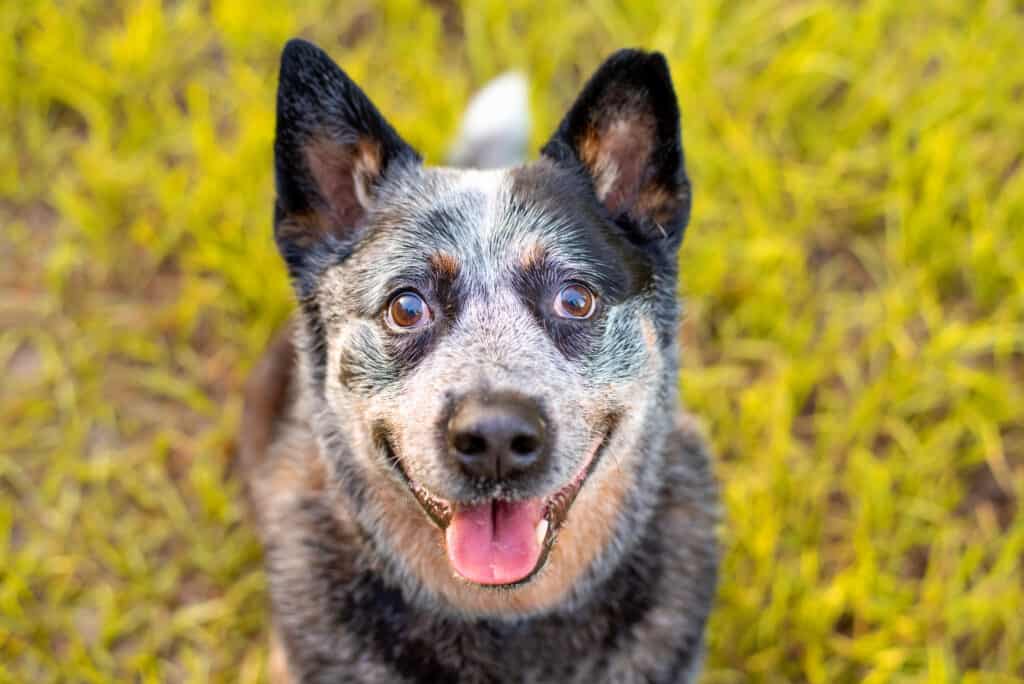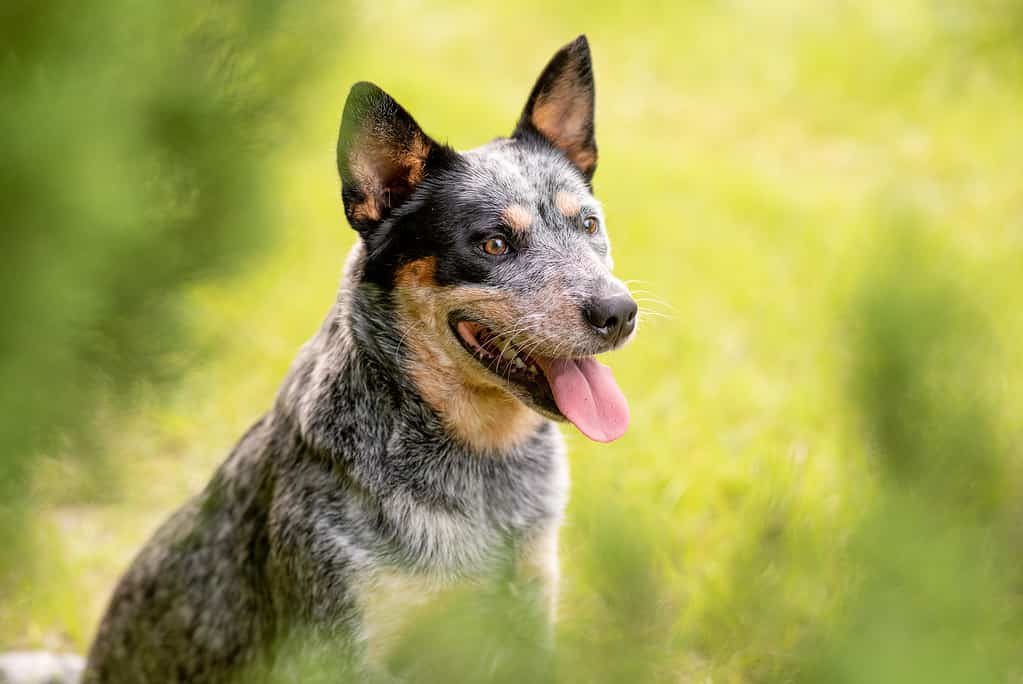This intelligent and energetic breed is a cross between multiple collie strains and the dingo. Originally bred in the 1800s by an Australian farmer to herd cattle, the blue heeler is immensely active and hard-working. Both male and female blue heelers are born with a thick, weather-resistant white coat. As they mature, it turns into a unique shade of blue or blue-grey. They are strong, lean, and muscular, making them great companions for hunting, fishing, and moving livestock. If given the proper amount of exercise and stimulation, these fascinating animals will live to be between 12 and 16 years old.
Whether you’re looking for a guard dog to help protect your family, or a particular dog breed to help maintain your farm, you need to know if a male or female blue heeler is right for your household. Of course, regardless of sex, no two dogs are alike, and just like humans, each has its own personality. Still, to give you a general overview, let’s take a look at some of the differences that exist between the two sexes and offer an overall comparison.
Comparing a Male and Female Blue Heeler
| Male Blue Heeler | Female Blue Heeler | |
|---|---|---|
| Physical Appearance | 18-20 inches at shoulders, 35-50 pounds. | 17-19 inches at shoulders, 30-45 pounds. |
| Temperament | High energy, intense, and extremely loyal. | High energy, intense, and extremely loyal. |
| Aggression | Overprotective, wary of strangers. Males have more of a tendency to bite and/or nip at the ankles. | Overprotective, and may nip at the ankles if they feel anxious or threatened. |
| Training | Intelligent, and hard-working. They tend to be stronger and have faster reactions. | Intelligent and hard-working. Females mature faster and are less hyper, which may make them easier to train. |
| Reproduction | Reaching maturity at six months old, they begin marking their territory and exhibit behaviors such as humping. | Reaching maturity at six months old, a female will go into heat twice a year annually. |
#1: Male vs. Female Blue Heeler: Physical Appearance

The blue heeler’s coat is unique due to breeding collies with other herding dogs.
©iStock.com/Tatyana Consaul
When it comes to the physical appearance between male and female blue heelers, there are only two distinct differences, one being their size and the other being the density of their hair. While both sexes are lean and muscular, according to the American Kennel Club, the male blue heeler tends to be a little larger ranging between 18 to 20 inches for males, and slightly heavier, weighing between 35 and 50 pounds. The female version of this dog breed ranges between 17 to 19 inches in height and typically weighs between 30 to 45 pounds.
Secondly, while both sexes are born with dense, weather-resistant fur, a male blue heeler’s coat is slightly thicker. Their thick coat of fur makes them capable of living in and surviving various weather elements.
#2: Male vs. Female Blue Heeler: Temperament

With their tremendous energy levels, blue heelers make great work dogs.
©Tatyana Consaul/ via Getty Images
Blue heelers are known for having a tremendous amount of energy and being extremely intense. This is why they make such great work dogs. With the need for at least one hour of exercise per day, they enjoy running, hiking, hunting, and playing fetch. While some owners say female blue heelers are more devoted, both are extremely loyal and tend to become attached to their owners. If this type of dog breed doesn’t receive enough stimulation, it may get bored and engage in destructive behavior such as tearing apart your beloved furniture or possibly destroying your carpet.
#3 Male vs. Female Blue Heeler: Aggression
Many people find blue heelers aggressive because they tend to be overprotective, and wary of strangers. They also tend to nip due to their instinctive herding drive. Nipping is a hard-wired herding trend of this dog breed used to get cattle moving.
Some studies have shown that male blue heelers are six times more likely to bite; however, not enough research has been done to prove this is always the case. Also, as there are different types of aggression, male blue heelers are often more territorial while female blue heelers often become aggressive when their babies are born, honing in on that maternal instinct.
#4 Male vs. Female Blue Heeler: Training Differences

Blue heelers are intelligent dogs, but their high energy levels can make training difficult.
©Chris Curtis/Shutterstock.com
These fascinating canines are so incredibly smart and full of energy, there isn’t much they can’t do. They need a job to help keep them active. With proper training, both sexes are obedient and respond well to positive feedback. Some people may find training this dog breed difficult due to its intense energy levels. It’s important to be consistent and start when these dogs are young and keep them occupied. An unstimulated male or female blue heeler can incite bad behavior to gain attention and interaction.
#5 Male vs. Female Blue Heeler: Reproduction
Other than the size difference, the other disparity is quite apparent. Female blue heelers can become pregnant and carry puppies. Unneutered male and female blue heelers start going into heat around six months old and continue to do so twice a year. Once the female is pregnant, she will continue to carry the pups for nine weeks before giving birth.
Choosing the Best Blue Heeler Sex for Your Family’s Needs
Deciding on a breed of dog can be difficult. Factoring in sex as well can make it even more challenging. But when it comes to the blue heeler, the differences between the two sexes are quite minimal. Unless you are planning to breed, the only major difference is size. Both the male and female blue heeler will make for a great family pet, work pooch, or guard dog. These beloved canines will keep you active, remain loyal for life, and protect you from danger. Just remember to offer them the stimulation and exercise they need, or boredom can lead to an unhappy pet, which will lead to unhappiness for everyone involved.
The photo featured at the top of this post is © iStock.com/Carmelka
Ready to discover the top 10 cutest dog breeds in the entire world?
How about the fastest dogs, the largest dogs and those that are -- quite frankly -- just the kindest dogs on the planet? Each day, AZ Animals sends out lists just like this to our thousands of email subscribers. And the best part? It's FREE. Join today by entering your email below.
Thank you for reading! Have some feedback for us? Contact the AZ Animals editorial team.







